Peripherals of Mobile Phones
Greedy Snake

The concept of the game is based on the "Blockade" arcade game released by the game developer Gremlin in 1976. The game itself did not have the concept of "snakes", instead the game was played by two pixelated characters building a wall on their way through, whoever hit the wall first or the other person would lose the game.
In 1997, an engineer from Nokia, the manufacturer of mobile phones, programmed a game called "Greedy Snake" and introduced the concept of "snakes" into the game. The player controls the direction of movement of a snake that is constantly moving in search of food. When the snake reaches for food, its body grows. While feeding, the snake must avoid touching its own body or other obstacles. Each time the snake eats a food item, it moves faster, making the game progressively more difficult.
The game was first introduced by Nokia in late 1997 with the Nokia 6110 mobile phone. Since then, the game has been introduced on a number of mobile phone models and has become a very popular classic game. Visitors can revisit this classic game through the interactive exhibit "Snake".
On the interactive exhibit, there are four buttons, one for each of the four directions: up, down, left and right, visitors can press any button to start the game. Once the game begins, the visitor controls the green snake as it moves to eat the most of the red food. Each time the snake eats a food item, its body grows by one frame and its moving speed increases. The game will end when the snake touches its own body or the border around it.
Color Screens
Screen resolution, also known as 'screen definition', refers to the number of pixels displayed on a screen. A screen with a resolution of 1920 x 1080 means that there are 1920 pixels per horizontal row and 1080 pixels per vertical column. The higher the resolution, the more detailed the image will be for the same screen area.
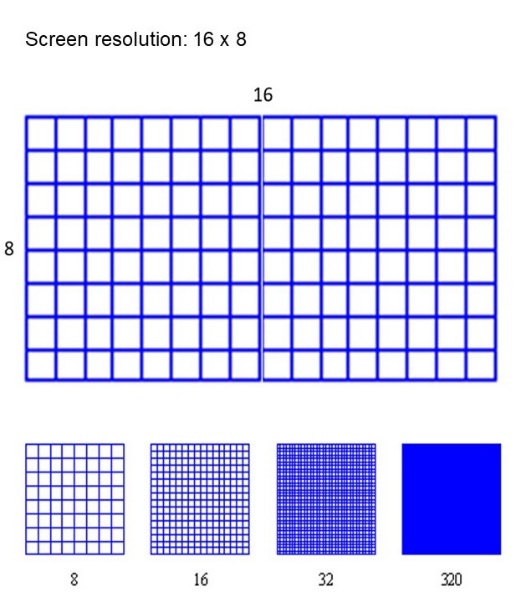 Figure.: Illustration of different resolutions
Figure.: Illustration of different resolutions
Pixel: A pixel is the most basic unit of image display. Each pixel on a color screen is usually made up of three color units: red, green and blue. The more pixels in a unit area, the higher the resolution and the finer the image can be displayed.
 Figure.: Screen illustration, showing the three RGB dots in one frame enlarged<
Figure.: Screen illustration, showing the three RGB dots in one frame enlarged<
The Three Primary Colors of Light: The red, green and blue colors. By adjusting the ratio of these three colors of light, different colors of light can be mixed. Based on this principle, each pixel of a color screen contains a light-emitting unit of each of these three colors. Using individual color mixing for each pixel, different images can be displayed on the screen. The pixels in a high-resolution screen are so tiny that it is difficult for the naked eye to detect that each pixel is a mixture of the three primary colors.
 Figure: Mixing of the three primary colors of light
Figure: Mixing of the three primary colors of light
This interactive display is made up of a color screen module, a microscope and buttons. The buttons represent the red, green and blue light emitting units. The more times you press a key, the brighter the corresponding light-emitting unit becomes. Visitors can adjust the brightness of the three colors in the color screen pixels, the color screen will display different colors, and by looking through the microscope, you can see the variations of the three color units in the pixels of the color screen module.
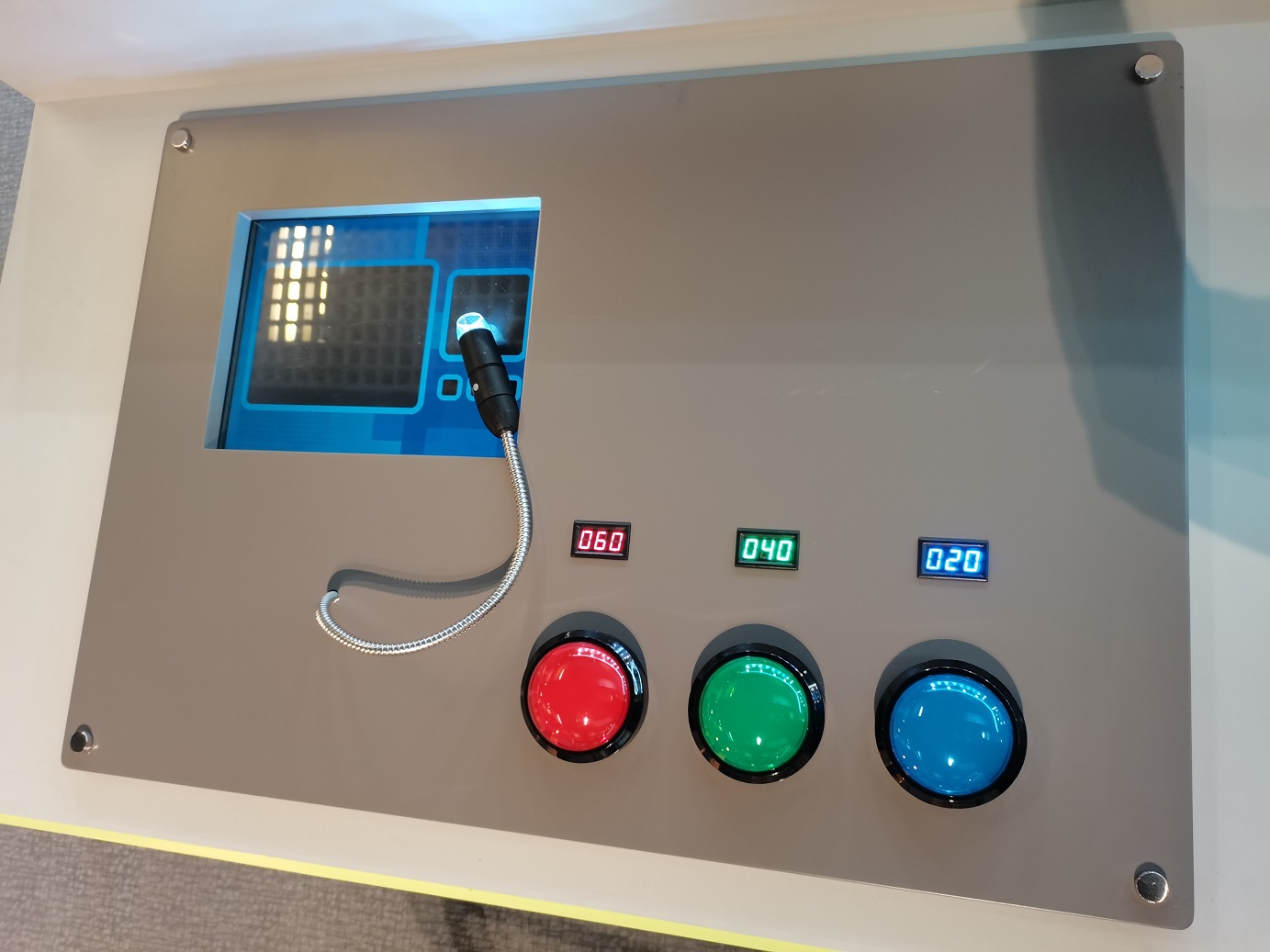
Inductive Wireless Charging
Wireless charging is one of the emerging charging methods used not only for mobile phones but also for other products such as smart watches, wireless headsets, tablets, home appliances, and even electric cars. Wireless charging technology can be divided into two main types of technology: inductive charging and resonant charging. Resonant charging simply requires the device to be placed within a limited distance of the wireless charger, and it can be charged with no contact necessary. Inductive charging requires bringing the device close to or touching the wireless charger and aligning the charging coils inside the two to charge. Due to business considerations, cost and technical factors, inductive charging currently remains the dominant type of wireless charger.
The principle of inductive wireless charging is based on Faraday's principle of electromagnetic induction, whereby electricity induces magnetism and magnetism induces electricity, transmitting energy without a cable connection. When a wireless charger senses a compatible charging device within range, current flows through the transmitting coil of the charger generating a magnetic field, and the receiving coil of the charging device will simultaneously induce a change in the magnetic field and generate a current to power the device's battery. The efficiency of the power transfer is influenced by conditions such as coil size and the distance between them. The closer the coils are to each other, the better the transfer efficiency. Therefore, the charging device and charger are generally placed close together, so that the internal charging coils are aligned with each other to achieve the best transfer efficiency.
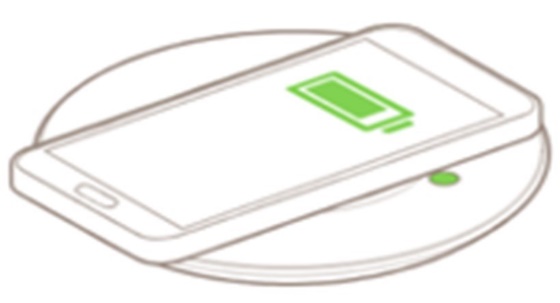 Figure: Induction wireless charging placement illustration
Figure: Induction wireless charging placement illustration

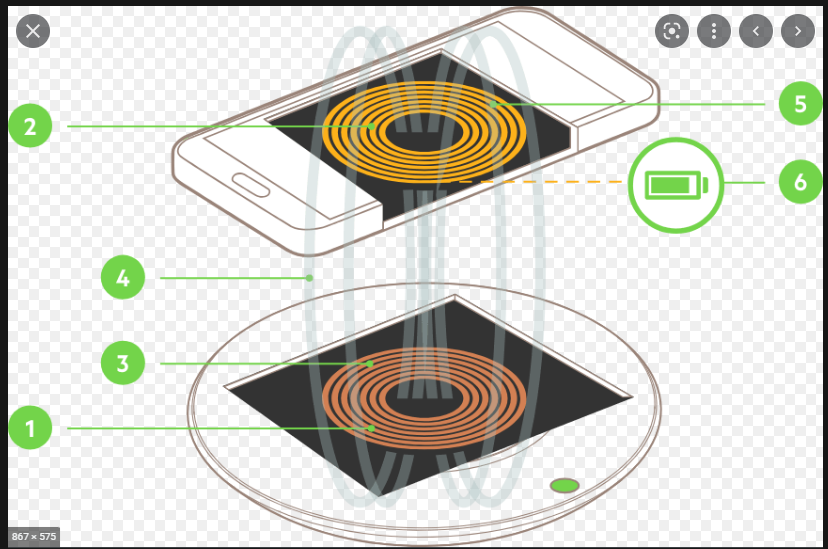 Figure: Principle of inductive wireless charging
Figure: Principle of inductive wireless charging
Advantages: When charging, no wiring is required, simply place the device near the charger, which is convenient and fast. Furthermore, the risk of electrocution when connecting wires can be avoided.
Disadvantages: Compared with wired charging, wireless charging is less efficient, it is slower, more expensive, has heating problems, and the mobile equipment cannot be moved freely while charging. In addition, due to the different standards of the chargers, the devices are not fully compatible with different charging specifications.
Visitors can learn about the basic components of wireless charging equipment through the interactive exhibit "Wireless Charging". Each wireless charging unit basically consists of a transmitter and a receiver. The basic structure of a wireless charging device can be understood by examining the various components that make up the exhibit. When the mobile phone is placed on the charger stand (i.e. wireless charging transmitter) on the right side of the base tray, the voltmeter will show the charging voltage being charged.
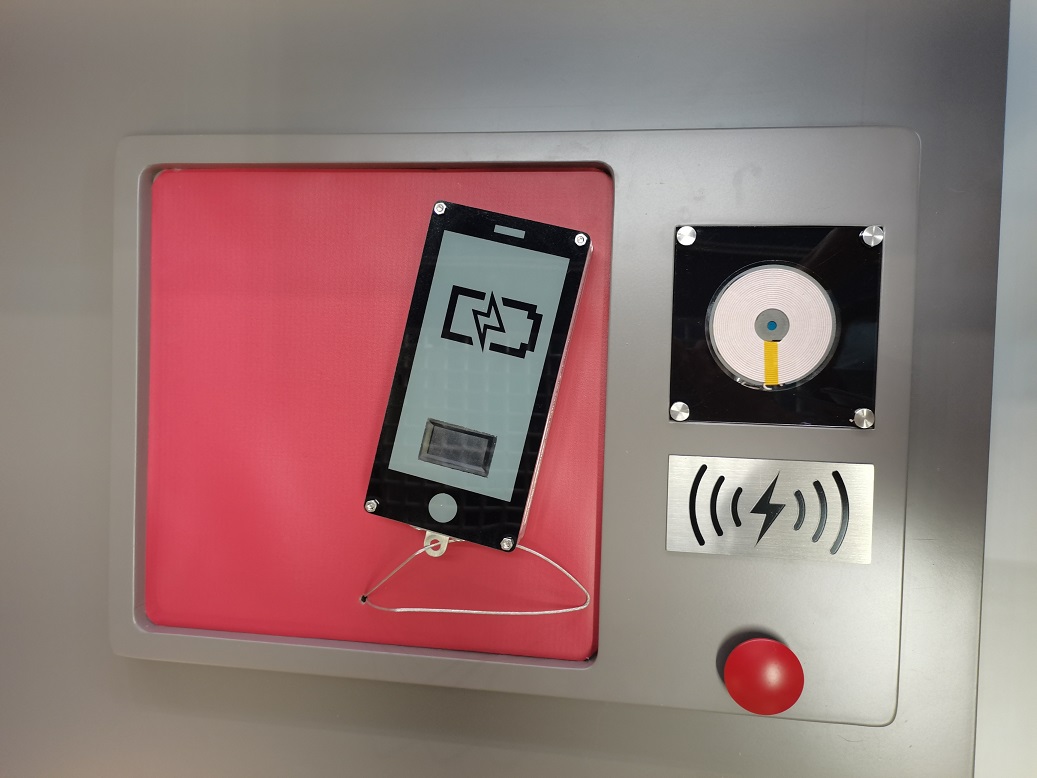
Mobile phones and Rare-Earth Elements
Rare earth elements: also known as "rare earth metals", consisting of 17 types: scandium (Sc), yttrium (Y), lanthanum (La), cerium (Ce), praseodymium (Pr), neodymium (Nd), promethium (Pm), samarium (Sm), europium (Eu), gadolinium (Gd), terbium (Tb), dysprosium (Dy), holmium (Ho), erbium (Er), thulium (Tm), ytterbium (Yb) and lutetium (Lu). Among them, yttrium (Y), lanthanum (La), cerium (Ce), praseodymium (Pr), neodymium (Nd), europium (Eu), gadolinium (Gd), terbium (Tb) and dysprosium (Dy) are often used in the manufacture of components for mobile phones.
 Figure: The 9 elements on the full periodic table are highlighted and magnified
Figure: The 9 elements on the full periodic table are highlighted and magnified
Color screens of mobile phones make use of rare earth elements such as lanthanum (La), terbium (Tb), praseodymium (Pr) and europium (Eu), whose ions emit different colors of light when stimulated by energy to bring out the color on the screen, while some rare earth elements can also block ultraviolet light from entering the screen. For example, camera lens uses glass containing lanthanum (La), which has a high refractive index and low dispersion, to enhance the lens's ability to provide better image quality. On mobile phones, Neodymium magnets, a powerful magnet containing neodymium (Nd), are used in the audio, video, and measuring components. On microphones and amplifiers, praseodymium (Pr), gadolinium (Gd), and neodymium (Nd) are used, and neodymium (Nd), terbium (Tb) and dysprosium (Dy) are used for vibration units.
Visitors can learn about rare-earth elements contained in the components of mobile phones, through the interactive exhibit "Rare-Earth Elements and Mobile Phones". This exhibit shows a disassembled color screen, camera lens, speaker, vibration motor, circuit board and other components from a mobile phone. By pressing the button corresponding to each rare-earth element, the mobile phone components containing that element will be illuminated.

Batteries for Mobile Phones
Nickel-Cadmium (Ni-Cd): These are the earliest batteries for mobile phone and have the advantage of low internal resistance, providing high current to the load and a quick charging time, but their biggest drawback is the "memory effect". When the battery is not fully discharged before charging, the repeated operation will result in a reduction in the maximum capacity of the battery and affect its performance. Cadmium is also a toxic heavy metal that is harmful to the environment and the human body, so Ni-Cd batteries have been phased out in the field of electronic equipment.
Nickel Metal Hydride (Ni-MH): A modified version of the Ni-Cd battery, replacing cadmium with a metal that can absorb hydrogen. Ni-MH batteries do not have obvious "memory effect" and do not contain the toxic heavy metal cadmium. They have a better recycling rate than lithium-ion batteries and are less polluting to the environment, it is considered the most environmentally friendly batteries. Nickel-metal hydride batteries have a higher capacity than nickel-cadmium batteries, but not as high as lithium-ion batteries. The average NiMH battery has a higher self-discharge effect of around 30% per month compared to 20% per month for Ni-Cd batteries.
Lithium-ion (Li-ion): Li-ion batteries have higher capacity than Ni-Cd and Ni-MH batteries, higher power output, faster charging and discharging rate, and only a very slight 'memory effect' with low self-discharge rate (about 5% per month) when not in use, making them one of the most common types of rechargeable battery available today. Unlike other rechargeable batteries, lithium-ion batteries deteriorate slowly and naturally over the life cycle, and their total capacity decreases over time even when simply stored unused. Due to the nature of lithium ions, these batteries are also not resistant to overcharging and over-discharging. Improper use can result in severe battery explosions, so lithium-ion batteries need to be designed with multiple protection mechanisms to minimize potential safety concerns.
Lithium polymer (Li-Po): A modified version of the lithium ion battery, lithium polymer batteries are often referred to simply as "lithium batteries" but they are strictly speaking not the same as lithium ion batteries. Li-polymer batteries use a gel or solid polymer in place of the liquid organic solvent in a lithium-ion battery, allowing it to be shaped as required and for greater flexibility in choosing the shape of the battery packaging. In addition, lithium polymer batteries have a longer service life than lithium ion batteries. Although they are safer than lithium-ion batteries, they can expand or catch fire if too hot. In terms of environmental impact, the use of lithium as a raw material for the production of batteries consumes significant amounts of water and the use of Rare-Earth Elements in the manufacture of lithium polymer batteries increases the impact on the environment and ecology as lithium polymer batteries become more widely used.
The next generation of batteries:
Lithium, the most important of the materials needed to make batteries, but its stock will not sufficient to meet the needs of global demand. With demand for the raw material far outstripping supply, scientists and engineers have been actively searching for alternative materials in recent years, and one such alternative is sodium, a fellow element of lithium on the periodic table. Sodium is on average 423 times more abundant in the earth's crust than lithium, and because it is so widely available, it is far cheaper to mine, and estimated to be at least 40% cheaper to produce than lithium polymer batteries, whilst more environmentally friendly as it does not require Rare-Earth Elements (REEs) in the production process and saves water. With the advancement of science and technology, the new generation of sodium batteries is expected to be the mainstream of the new generation of batteries.
Visitors can learn about the different generations of mobile phone batteries on display, through the interactive exhibit "Batteries for Mobile Phones".
| Type of Battery | Ni-Cd | Ni-MH | Li-ion | Li-Po |
| Mass energy density (W?hr/Kg) | 40-50 | 50-60 | 90-110 | 100-120 |
| Volumetric energy density (W?hr/L) | 130-200 | 200 | 250-300 | 200-300 |
| Operating voltage (V) | 1.2 | 1.2 | 3.6-3.8 | 2.7-4.2 |
| Safety issue | High | High | Low | Low |
| Memory Effect | Severe | Moderate | Slight | Slight |
| Self-discharging effect | ~25%/month | ~30%/month | ~5%/month | ~5%/month |
| Charge cycle durability | ~800 cycles | ~800 cycles | >1000 cycles | >1000 cycles |
| Environmental impact | Severe | Minor, highest battery recycling rate | Moderate | Moderate |
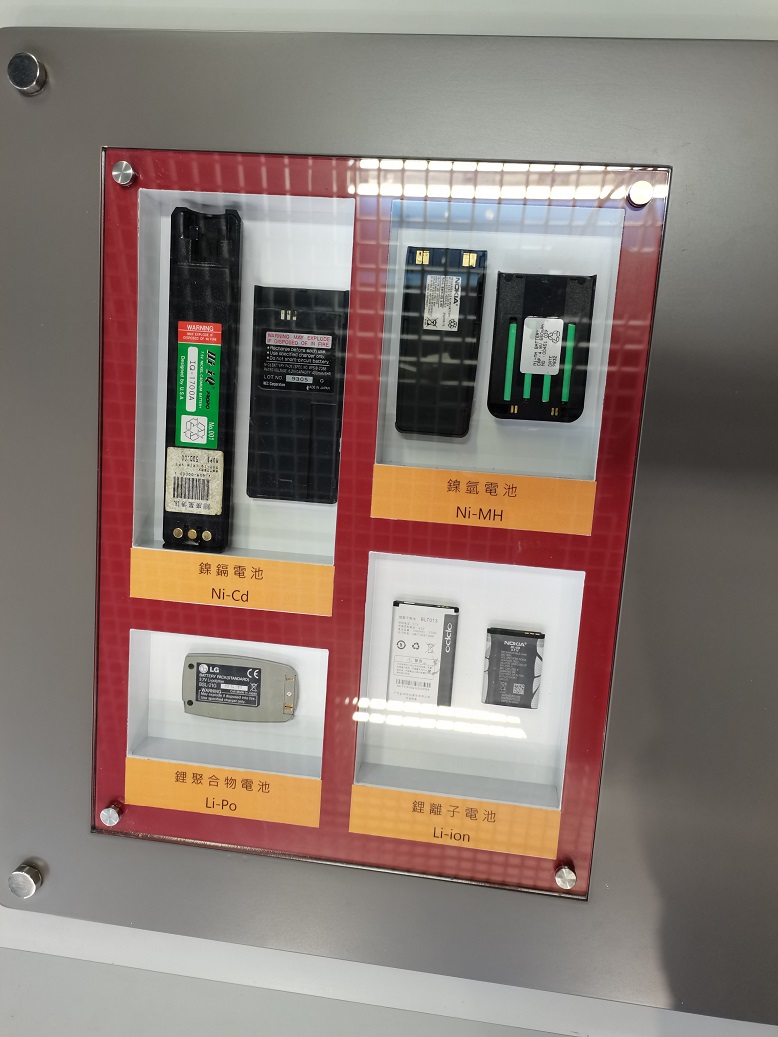
Connection of Mobile Phone
Mobile phones did not start out with the need to connect to other devices, as the development of technology and more popular of mobile phones, users have the need to exchange information with networks and other devices. Generally speaking, mobile phones can be connected in two different ways: wired and wireless. Before wireless connectivity was not yet widespread, most mobile phones used their own charging ports for data transmission. However, as there was no standardized connector for mobile phones, a wide variety of common connectors like, the 30-pin flat wide connector, Mini USB connector, Micro USB connector, Lightning connector and USB Type-C connector were used. This incompatibility of the different brands and models of ports led to confusion and created a large amount of electronic waste.
In view of this, the European Union has passed a bill in 2022 that makes it mandatory for all electronic devices such as mobile phones sold in the EU to use USB Type-C as the standard interface by 2024. We believe that in the future, mobile phones of different brands will tend to use the same interface for their wired connections.
Another connection that rapidly developed in recent years is the wireless connection, with infra-red transmission as its earliest form. The advantage of using infra-red is that the receiver is simple and inexpensive, however infra-red cannot cross solids or bends, so there must be an unobstructed, straight path between the transmission devices. There are also limitations in terms of transmission speed, effective distance and angle.
Bluetooth and Wi-Fi are gradually becoming the mainstream form of wireless connection for mobile phones. Bluetooth is a short-range wireless communication technology that requires less power and cost than Wi-Fi, and its lower power makes it less susceptible to interference. However, the Bluetooth transmission range is generally quite limited, usually extending to only about 10m, and the connection requires the devices to be paired with each other first, while the number of devices connected is also limited.
The Wi-Fi connectivity operates through a wireless router, allowing mobile phones access to the Internet and exchange information with other devices, while the number of connected devices, long transmission range (100m-300m) and high transmission rate (300 mb/s) are all advantages of Wi-Fi, though it consumes more power and is less secure than Bluetooth.
Current mobile phones are equipped with different ways for users to connect with each other. This exhibit shows an example of one of the devices that use wireless connection. By using the 'Bluetooth' function of the mobile phone in the exhibit, visitors can use the paired Bluetooth audio to play multimedia files from the phone.

About CMM
Contact US
Others
Other Websites
Number of Visitors:
Last Modified Date: 23/07/2024